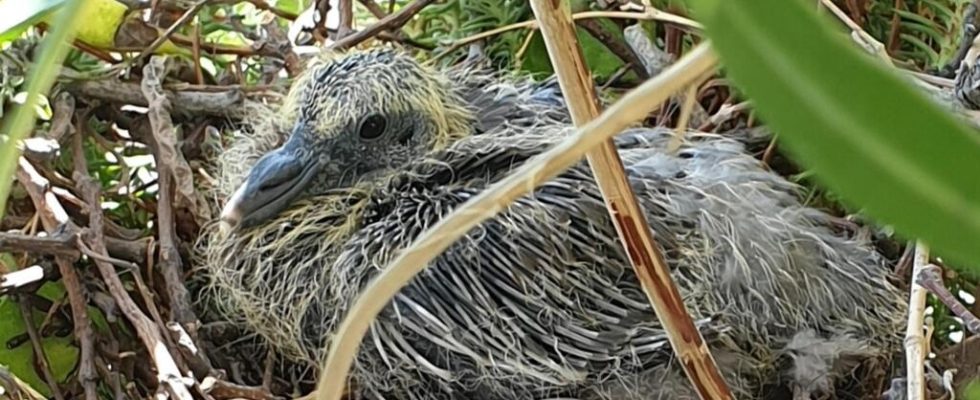It’s in your nature the chronicle of plants and animals, wishes a happy birthday to Rose, the pigeon born on July 4, 2022 on the terrace of Florent Guignard, who told us about this happy event last summer. And since Thursday, a couple of pigeons have been nesting and brooding again in the nest where Rose was born.
It was my niece, Clara, who discovered the surprise while filming the plants on the terrace: two small white eggs at the bottom of a nest made of twigs, hidden in the oleanders. A couple of wood pigeons have nested.
Two main species of pigeons coexist in Paris. Rock pigeons, domesticated pigeons, carrier pigeons originally; there are between 10,000 and 20,000 pairs. Of the “flying rats”, according to the Parisians. And then there are the doves, more beautiful and bigger, almost as big as a chicken, gray with a white collar, the edge of the wings white, and the yellow beak. Paris has around 3,000 pairs of pigeons.
loyal couples
The first pigeon in the French capital was observed in 1840, but much later in Lyon, in 1990. “The wood pigeon had established itself in towns surrounded by market gardens, whereas it had not settled in towns surrounded by forests.specifies Frédéric Mahler, ornithologist at the League for the Protection of Birds. In cities where there are market gardens, the wood pigeon has enough to eat, so it reproduces abundantly and there are plenty of wood pigeons. There is then no more room in a natural site and it is therefore “constrained” to discover the city. »
The pigeons form model pairs: faithful unto death, they take turns to incubate the eggs, for a dozen days. And then one morning, it was July 1, a little pigeon was born, hidden under its father or mother, who gave it its first meal. The second egg will never hatch, probably not fertilized.
milk fed
The first days, the youngster is fed with crop milk. Yes, rare birds nurse, such as pigeons or flamingos. And the male, like the female, produces milk. The beak is energetic, the adult regurgitates, opens its beak and the chick feeds deep in its throat. “Wood pigeons, numerous in Paris, do not necessarily feed in Paris. Most feed ten or twenty kilometers from Paris, in the fieldsexplains Frédéric Mahler. Their crop, the equivalent of their stomach, then secretes a liquid that looks like extremely rich milk. »
A very nutritious diet, only proteins and lipids: in 48 hours, the baby doubles its weight. Rose, because we called her Rose, born in the midst of oleanders, and whose belly will soon turn pink like all wood pigeons, is growing at an impressive speed. Physical changes and progress are daily. We can see them thanks to the little camera we installed. “It’s a bit the same principle as mammalian milksummarizes Frédéric Mahler. The little human also changes quickly when he drinks milk! »
The first day of the rest of his life
The yellow down gradually gives way to the first gray feathers. The parents leave the nest, but are never far away: having become territorial, they chase away the other pigeons that approach. They return to the nest for the beak, composed of regurgitated seeds, two to three per day. The juvenile is then all excited, utters little cries and its little wings quiver… At two weeks old, Rose looks more and more like a pigeon, looks down from the top of the ten floors at the world that awaits her, begins to do the a hundred paces and practice flapping their wings, a little more powerful every day.
And then one morning… it’s 7:17. Our little pigeon flaps its wings and climbs in the branches of the oleander, under the encouragement of its parents. It’s the big day, on the 22nd day. The big leap to his new life. Rose took off. The moment is touching. And since the nest seems very empty. All that’s left at the bottom is a small white egg.
THE QUESTION
“Isn’t a pigeon a bit silly?” »
He Ho ! We don’t talk like that about Rose! Admittedly, pigeons are less intelligent than crows, the other large bird that inhabits Paris. But pigeons, often despised, have a brain! The density of their nerve cells is six times greater than in humans. They are faster than us to accomplish two tasks at the same time. The pigeon travels hundreds of kilometers, thanks to its internal compass and its sense of smell. The more polluted the air it passes through, the more it accelerates, up to 70 kilometers per hour. A pigeon often returns to nest where it was born, like turtles. He also recognizes the face of a human who had abused him. Do not take a pigeon for a pigeon!
